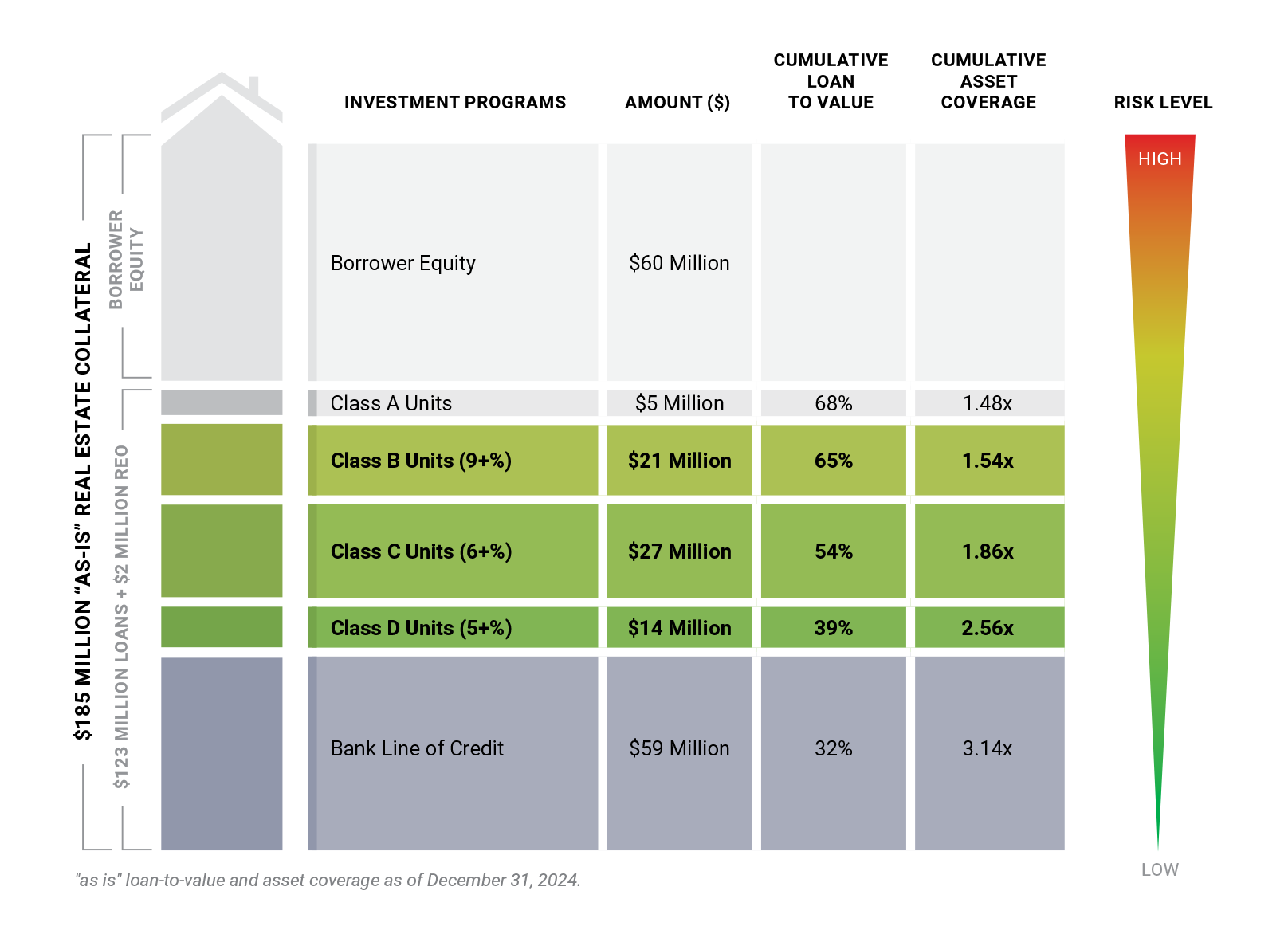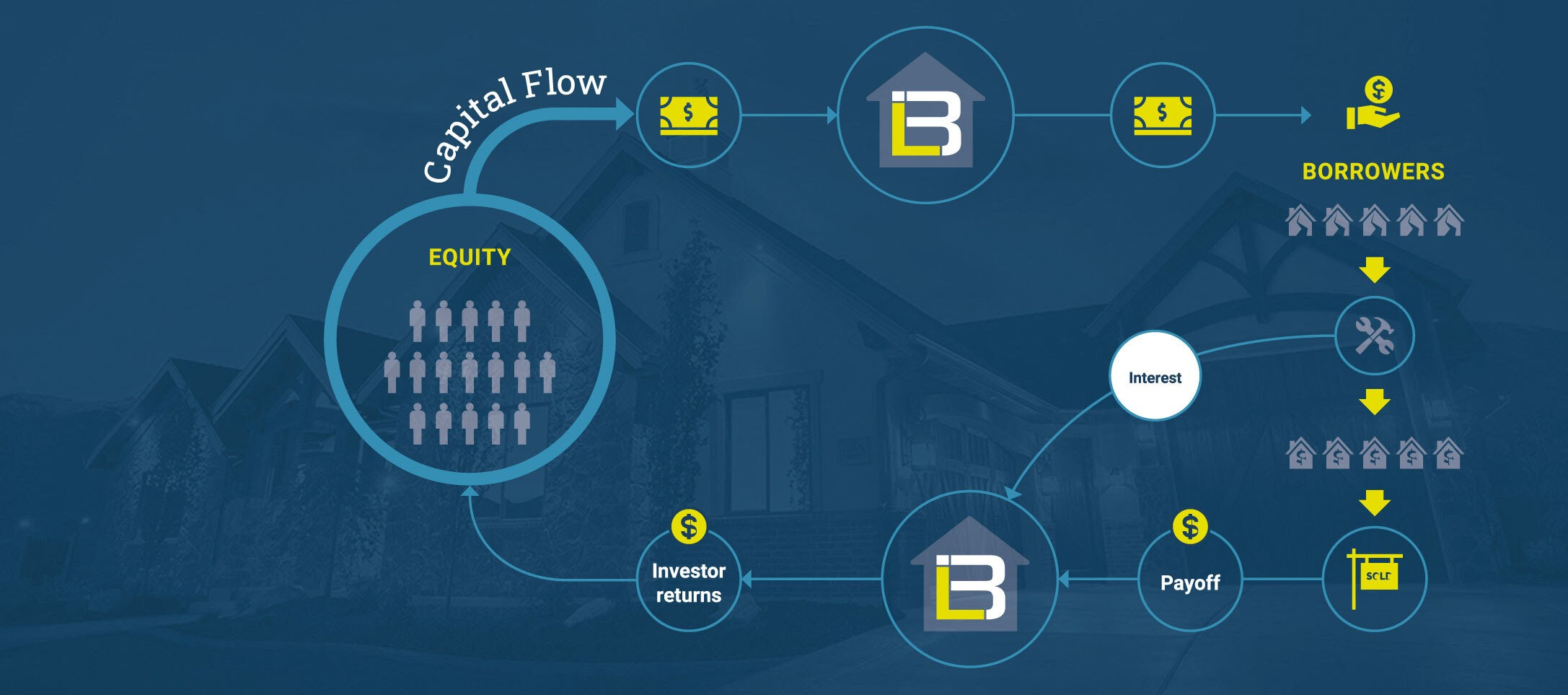Class B, C & D Units
Our Class B, Class C and Class D investment accounts (the “Equity Program”) provide different fixed rates of return plus profit participation. Investments are redeemable with 60 days notice, subject to certain limitations, and provide monthly profit distributions or optional reinvestment, allowing for maximum flexibility. By investing in a Mortgage REIT, taxable investors may benefit from the 20% 199A tax deduction, providing an additional tax-adjusted yield increase of approximately 1%. Tax advantaged investors benefit from no unrelated business taxable income (“UBTI”) tax related to debt financed income of the Company.
Security
Our fund structure offers multiple layers of protection for investors.
- All investment classes, totaling $125 million, are invested in a portfolio of approximately 244 short term (12 month maturity) loans, secured by an estimated $185 million of “as-is” real estate collateral value, or $60 million of our borrowers’ subordinate (at risk first) equity in the real estate projects.
- Tiered capital structure provides Class B, Class C and Class D investors with additional protection relative to Class A investors.
- Class B is further insulated by an additional $5 million of subordinate Class A, resulting in a 65% effective loan-to-value on the real estate collateral.
- Class C is further insulated by an additional $26 million of subordinate Class A and Class B, resulting in a 54% effective loan-to-value on the real estate collateral.
- Class D is further insulated by an additional $53 million of subordinate Class A, Class B and Class C, resulting in a 39% effective loan-to-value on the real estate collateral.


LIQUIDITY
Class B, Class C & Class D Units are redeemable with a 60-day notice, subject to certain limitations, which allows you to withdraw or add to your account quickly and easily.
14.9 million
Iron Bridge Revenue
1.7 X
2.2 X
2.9 X
Preferred Return Coverage
Our business model generates strong and stable recurring revenues available to make investor payments.
- 1.7 times the revenue needed to pay Class B investors.
- 2.2 times the revenue needed to pay Class C investors.
- 2.9 times the revenue needed to pay Class D investors.
Stability
The strength of our loan portfolio comes from our investment in the value creation of our borrowers. We do not speculate on the economy or the real estate market. Our loan portfolio has performed well in both down and up economies since 2009.
![]()
We invest in our borrowers and the talent they bring to their projects.
![]()
Our borrowers make money on the value they create in their projects.
![]()
Short term loans allow us to adapt quickly to changing markets.

"My wife and I love being able to use our two IRA accounts and a 401K plan to invest in Iron Bridge. Our monthly profit distributions are tax-deferred, and we elected to have those monthly profit distributions reinvested each month, increasing our annualized returns through monthly compounding. The Iron Bridge team also went out of their way to help us complete the paperwork required by the IRA and 401K custodians to initiate the investment."

"As the Head of School for an independent school, our investment objective for our endowment is to achieve stable long-term returns, sufficiently above the rate of inflation, to meet the current and futures needs of our school, faculty, and students. We made our initial investment with Iron Bridge in 2013 and have made additional invests over the years."

"I’m a real estate investor who purchases and sells several properties every year, which mean that I was frequently sitting on large amounts of cash in the bank earning little, waiting for the next deal to come along. With my Equity Program account, I’m now able to park cash with Iron Bridge in between my deals, earning a much higher rate of return and can pull that money back out on short notice when I need it."

"I like to invest in real estate to build and maintain a diversified portfolio. I don’t want to spend my time continually evaluating new real estate investments one-by-one. My Equity Program account solves this problem because I earn monthly profit distributions and my investment is spread across a portfolio of over 300 real estate loans located across 16 states."

"We invested with Iron Bridge for a number of reasons. One is that we can get a better return on our investment than we can in money market accounts while avoiding the uncertainties of the stock market. Knowing that our investment is backed by real estate is a comfort to us and having our funds available to us should we need them is a big plus. The monthly payments help with budgeting in retirement and have added confidence to our retirement portfolio. We have been happy with the performance and security of Iron Bridge and are considering additional investments."

"We made our first investment with Iron Bridge in 2011. Since that time, we’ve gained tremendous respect for and trust in Gerard and his team. Our family has added to its investment several times over the years. We appreciate the security of the real estate collateral and the monthly cash distributions, which we use to travel and to take care of mom."
Fund Management

Management
Gerard founded this company to provide for his family, perform a valuable service for his borrowers and deliver attractive returns to his investors.

Underwriting
With our in-house loan origination and underwriting process, we have intimate knowledge of the circumstances behind each loan we make.

Loan Servicing
In-house servicing means personal interactions with our borrowers, which leads to successful projects and excellent returns for borrowers and investors.

Frequently Asked Questions
What are the tax advantages of investing in a Mortgage REIT?
Iron Bridge Mortgage Fund converted from a partnership into a real estate investment trust in tax year 2022. Some of the tax advantages of investing in a Mortgage REIT are as follows:
- Taxable accounts receive the full 20% 199A tax deduction. In other words, for every $100 earned, investors will be taxed on $80.
- All tax advantaged accounts (e.g., IRAs, Profit Sharing Plans, Defined Benefit Plans) pay no unrelated business taxable income (UBTI) on the Company’s debt financed income.
- Investors receive a 1099-DIV tax form, which is similar in simplicity to a 1099-INT tax form (no complicated K1 tax forms).
- Investors are only liable for state taxes based on the investor’s state of residence and distributions received (no multi-state tax filings required)
Why is Iron Bridge offering Class B, C & D Units?
Iron Bridge’s capital structure is comprised of four tiers of equity (Class A, Class B, Class C and Class D), providing investors with different options to meet their investment needs. Class A is owned by employees of the Company only and is first at risk should a capital loss occur.
On February 1, 2021, the Company restructured its equity into Class A, Class B, Class C and Class D Units. Class D Units receive a 5% preferred return and are senior in security interest to Class C, Class B, and Class A. Class C Units receive a 6% preferred return and are senior in security interest to Class B and Class A but subordinate to (at risk before) Class D. Class B Units receive a 9% preferred return and are senior in security interest to Class A but subordinate to Class D and Class C. Class A Units are subordinate to all other equity classes and receives 90% of any profits in excess of the preferred return owed to Class D, Class C and Class B.
10% of any profit in excess of the preferred return owed to Class D, Class C and Class B is distributed proportionally to Class D, Class C and Class B investors as profit participation.
What is unique about the Equity Program?
- Risk Management – the Manager’s investment capital (invested in Class A Units) is at risk before outside investor capital, which incentivizes prudent risk management.
- Liquidity – Because the Company's loan portfolio turns over in approximately eight months, investors can withdraw their investment with 60-day notice to Iron Bridge, subject to certain limitations, providing investors with liquidity and flexibility.
- Flexibility - Monthly profit distributions can be reinvested, increasing the annualized investment return through compounding. Investors can also make deposits into their accounts at the start of any month. It’s a great way for investors to earn an attractive rate of return on capital that might otherwise be sitting in the bank.
What is my priority position as an Equity Program Investor?
All the Company’s equity classes (Class A, Class B, Class C and Class D) are invested in a portfolio of approximately 244 short-term (12 month maturity) real estate loans secured by first lien deeds of trust. The approximate average loan-to-value of the loan portfolio is 68%. In other words, the company’s loan portfolio, in which Equity Program investors are invested, is insulated from loss by approximately $60 million of our borrowers’ equity, which is at risk first (based on mortgage loans receivable, net, of $123 million).
However, each class of equity investment is further insulated by any subordinate (at risk first) equity class. For example, Class D is the most insulated investment program and has a senior priority interest on all the Company’s assets, ahead of Class A, Class B and Class C. In other words, Class D investors are insulated by our borrowers’ equity of approximately $60 million, plus the additional Class A, Class B, and Class C of approximately $53 million. As a result, Class D investors have an effective loan-to-value on the real estate collateral of 39%.
Similarly, the Class C is the second most insulated investment program and has a senior priority interest on all the Company’s assets ahead of Class A and Class B but is subordinate to (at risk before) Class D. In other words, Class C investors are insulated by our borrowers’ equity of approximately $60 million, plus the additional Class A and Class B of approximately $26 million. As a result, Class C investors have an effective loan-to-value on the real estate collateral of 54%.
Similarly, the Class B is the third most insulated investment program and has a senior priority interest on all the Company’s assets ahead of Class A but is subordinate to (at risk before) Class B, Class C and Class D. In other words, Class B investors are insulated by our borrowers’ equity of approximately $60 million, plus the additional Class A of approximately $5 million. As a result, Class B investors have an effective loan-to-value on the real estate collateral of 65%.
*The forgoing numbers are as of December 31, 2024.
How do I know that you will have sufficient revenues to pay my investment return?
For the 12 months ended December 31, 2024, the Company generated $14.9 million in total revenues available to pay interest expense and investor preferred returns. With average portfolio leverage of 43.3%, the Company paid interest expense of $4.2 million related to Bank Borrowings. The Company paid preferred returns of $0.8 million related to Class D Units, $1.7 million related to Class C Units and $1.9 million related to Class B Units.
Total revenue was 3.5 times the amount necessary to pay interest expense related to Bank Borrowings; 2.9 times the amount necessary to pay the interest expense and preferred returns related to Bank Borrowings and Class D Units combined; 2.2 times the amount necessary to pay the interest expense and preferred returns related to Bank Borrowings, Class D Units and Class C Units combined, and; 1.7 times the amount necessary to pay the interest expense or preferred returns related to Bank Borrowings, Class D Units, Class C Units and Class B Units combined.
In these calculations, the preferred return payable to Class D investors is combined with the interest payable on Bank Borrowings because Bank Borrowings have a senior security interest to Class D investors. Similarly, the preferred return payable to Class C investors is combined with preferred return payable to D investors and interest payable on Bank Borrowings because Class D investors and Bank Borrowings have a senior security interest to Class C investors, and; the preferred return payable to Class B investors is combined with preferred return payable to Class C and Class D investors and interest payable on Bank Borrowings because Class C and Class D investors and Bank Borrowings have a senior security interest to Class B investors. We believe that this level of coverage provides investors in each class a significant layer of protection that should help safeguard investor capital during an adverse economic event.
What are Bank Borrowings?
Iron Bridge has an $80 million (increased from $60 million at 12/31/23) line of credit with Umpqua Bank, which has a senior security interest in all the Company’s assets. The Company targets a line of credit utilization rate of 50-80%, which allows the Company to meet unanticipated loan requests from borrowers or unanticipated withdrawal requests from investors. Similarly, if the Company’s portfolio loans pay off faster than anticipated or if new loan originations do not match the rate of loan payoffs, the line of credit can be paid down while keeping investor capital fully utilized.
What is the Class Limitation and how is it calculated?
How many loans has Iron Bridge made since inception and how did they perform?
As of December 31, 2024, the Company had originated 5,218 loans since inception (April 1, 2009) of which 4,974 had paid off and 50 had become REO properties through either the foreclosure or deed in lieu of foreclosure process, resulting in a net 244 active Portfolio Loans.
As of December 31, 2024, the Company’s allowance for loan losses equaled 1.6% of the active loan portfolio. This compares to the Company’s total loan charge offs of 0.193% since inception (2009). See the Company’s offering circular and most recent quarterly report for more details.
How much capital does the Company currently have invested in Portfolio Loans?
As of December 31, 2024, the unpaid principal balance of the Company’s loan portfolio was $126.1 million. The loan portfolio consisted of 244 active loans provided to 128 borrowers. The average number of loans per borrower was 1.9 loans. The largest borrower represented 8.2% of the unpaid principal balance while the top 3 borrowers represented 17.3% of the unpaid principal balance. See the Company’s offering circular and most recent quarterly report for more details.
How long does the Manager intend to operate the Company?
What are Iron Bridge’s underwriting guidelines?
For each prospective borrower, the Company performs a criminal background check, orders a credit report, measures liquidity, interviews the borrower to assess experience level and evaluates the quality of previous work. The Company also requires each borrower to provide a construction cost budget, detailing the cost and scope of planned capital improvements, and a profit analysis, detailing the borrower’s estimated resale price, total project cost and estimated profit.
As an asset-based lender, the Company’s underwriting guidelines are heavily weighted toward real estate valuation, liquidity and loan-to-value (LTV) coverage.
Specifically, the Company operates under the following underwriting guidelines:
- The Company does not lend more than 70% of the estimated “after-repair value” of the collateral;
- the Company does not lend unless secured by a first lien deed of trust or mortgage;
- the Company does not lend unless the borrower has a clearly defined exit strategy; and
- the Company does not lend without assessing the borrower’s ability to pay.
The Company has the sole discretion whether to originate a mortgage loan at a given LTV. Some of the factors considered by the Company when determining the maximum LTV to be extended on a mortgage loan are:
- age, type, condition, and location of the collateral;
- borrower creditworthiness and credit history;
- loan amount and credit terms requested;
- additional cross-collateralized properties;
- proposed changes to or reconstruction of the collateral;
- tenant history and occupancy rate (if applicable); and
- amount of the interest reserve or construction loan (if any).
How will the Company react to future changes in the housing market?
Our private lending business has performed well in both increasing and decreasing real estate pricing environments since inception (2009) and is not dependent on a high volume of distressed real estate sales, a restrictive lending environment or appreciating real estate values. It is important to understand that our borrowers create value in their real estate projects by making strategic capital improvements, and Iron Bridge shares in the borrower’s value creation by making a loan secured by the real estate collateral and receiving interest payments. As the real estate environment changes, Iron Bridge will adapt by shifting its loan portfolio to different geographic markets and adjusting its loan programs and related underwriting guidelines accordingly.
Where does the Company source most of its loans?
The company has developed and continues to develop a network of real estate investors who have a need for private real estate financing to execute their investment strategies. These investors are professional home builders, developers, rehabbers, remodelers, or other real estate-oriented professionals who utilize different techniques to acquire, improve and resell real property.
A common misconception is that these borrowers must be low quality with bad credit scores otherwise they would borrower from a bank lender. On the contrary, these borrowers generally have good credit, experience and liquidity. However, they choose to use private financing over bank financing due to the superior speed and efficiency.
If Portfolio Loans become non-performing, what happens?
Iron Bridge underwrites each loan with the expectation that if it must foreclose on the property, there will be sufficient equity in the real estate collateral to insulate Iron Bridge from a capital loss. The Company relies on outside counsel to manage the foreclosure process. In some cases, it is possible that the Company will earn a greater return on non-performing loans due to the late fees and default interest rates that apply. If the final disposition value of a foreclosed property is less than the principal plus accrued interest due, then the amount of the shortfall is booked against the Company’s allowance for loan losses. The allowance for loan losses further insulates investors from capital loss. As of December 31, 2024, the allowance for loan losses was $2 million or 1.6% of the unpaid principal balance of the loan portfolio. See the Company’s most recent quarterly report for additional details regarding non-performing assets and allowance for loan losses.
What assurances do I have that I will not lose my money?
There can be no assurance that an investor will not lose some or all of their investment in the Company. However, the Company has established the following guidelines to minimize risk and maximize the preservation of capital: (a) All of the Company’s Portfolio Loans are secured by first lien deeds of trust or mortgages on real property; (b) The Company does not lend more than 70% of the estimated after- repair value of the real estate collateral; (c) The Company seeks to maintain strong cash flow generation and preferred return coverage ratios, which are reported to investors quarterly, and; (d) each investment class is further secured by the subordinate (at risk before) investment classes. The Company reports to investors each quarter the “loan-to-value”, “asset coverage” and “preferred return coverage” of each investment class.
It is also important to point out that Class A (owned by employees only) is first at risk of capital loss, which we believe incentivizes prudent risk management.
Has Iron Bridge ever been in default with any of its creditors or investors?
Have investors ever lost money in Iron Bridge or another investment sponsored by the Manager or its Principals?
No. Since the Company’s inception (2009) no investor has ever lost money in Iron Bridge Mortgage Fund, and all monthly profit distributions or interest payments have been paid to investors in full, when due. Iron Bridge Mortgage Fund is the only investment program that has ever been sponsored by the Manager or its Principals.
While we hope to continue this successful track record, there is no guarantee we will be able to do so. See the risks described in our Offering Circular for more details.
How is Iron Bridge confident it will have the cash flow necessary to return my investment capital when I need it?
The Company makes short-term loans with maturities of 12 months or less. These Portfolio Loan payoffs provide a primary source of cash flow to the Company, which can be used to pay back investors or make new loans. For the twelve months through December 31, 2024, Portfolio Loan payoffs totaled $200 million or an average of over $16 million per month. In addition, Iron Bridge targets a line of credit utilization rate of 50-80% on its $80 million bank credit line, which would provide approximately $40 million to $56 million in line of credit borrowing capacity to meet investor withdrawal requests. See the Company’s offering circular and most recent quarterly report for more details.
What happens if all Iron Bridge investors want their money back at the same time?
While Iron Bridge intends to fulfill all redemption requests from investors, and historically has been able to do so, its redemption program is subject to a number of limitations. For example, if the Company has unfulfilled Redemptions Requests at any time from Members collectively seeking redemption for more than thirty percent (30%) of outstanding Units, then the Company may elect to (A) suspend processing Redemption Requests in the order received; (B) extend the redemption date for all Members until such time as the Company has sufficient liquidity to complete such redemptions without causing a material adverse impact on the Company, with no requirement of the Company or the Manager to market or sell any Investments or other assets at fire sale or discount prices to complete any outstanding Redemption Requests, (C) make payments, or prepayments as applicable, to Members who have submitted a Redemption Request, provided, however, that any such payments or prepayments shall be made in the following order of priority: bank line of credit, Class D Units, Class C Units, Class B Units, then Class A Units; and (D) give notice to all Members that the Company is electing to take the actions set forth in subsections (A), (B) and (C) above. See the Company’s offering circular for more details.
Are there any redemption limitations?
Under the Redemption Program, the Company will redeem Units up to a maximum of 5% of the total aggregate members' equity of the Company per quarter, calculated in accordance with GAAP as of the last day of the previous calendar quarter, which means that our net redemptions will be limited to approximately 20% of our total members' equity in any 12 month period. If redemptions do not reach the 5% limit in a calendar quarter, the unused portion generally will be carried over to the next quarter, but not any subsequent quarter, except that the maximum amount of redemptions during any quarter may never exceed 10% of the combined total assets less total liability of the Company as of the last day of the previous calendar quarter.
How is the Manager compensated and do I pay a fee to the Manager?
What ongoing financial reports will Iron Bridge provide Equity Program investors?
In connection with this offering, the Company will also be required to file with the Securities and Exchange Commission (“SEC”) annual, semiannual, and current event reports for so long as offers and sales of Equity Program units are ongoing. These SEC reports will be available to investors when filed with the SEC.
The Company’s books and records are maintained on the accrual basis for accounting purposes and for reporting income and losses for federal income tax purposes.
What accounting firm performs the annual financial audit of Iron Bridge and for how many years?
From 2011 through 2021, the Company’s financial auditor was Armanino. In 2022, the Company changed financial auditors to Perkins & Co. Perkins & Co. that brings industry expertise surrounding real estate and more specifically mortgage pools, providing Iron Bridge with proactive counsel throughout the year. Copies of all financial audits are available upon request.
What IRS tax forms will Iron Bridge provide Equity Program investors?
Can I reinvest my monthly profit distributions and what investment returns can I expect?
Upon subscription for Units, investors are automatically treated as having elected to reinvest all distributions made with respect to their Units, unless a cash distribution election is made. In each case, the reinvestment of distributions by a member in additional Units shall be at a purchase price equal to the offering price of such Units if the Company is currently offering such Units, or if no offering is being conducted, the NAV as of the last date of the month preceding such reinvestment, as determined by the Manager in its sole discretion. Equity Program investors who choose monthly reinvestment will benefit from compounding monthly returns and an increased annualized yield. In addition, taxable investors may receive the full 20% 199A federal tax deduction.
- If the Class D investment return is 5.2% (5% preferred plus 0.2% participation), then the compounded annual rate would be 5.3%, and the tax-adjusted equivalent rate would be approximately 5.8%
- If the Class C return is 6.2% (6% preferred plus 0.2% participation), then the compounded annual rate would be 6.4%, and the tax-adjusted equivalent rate would be approximately 6.9%
- If the Class B return is 9.2% (9% preferred plus 0.2% participation), then the compounded annual rate would be 9.6%, and the tax-adjusted equivalent rate would be approximately 10.2%
To manage its capital structure, the Company requires Class B investors whose monthly distributions are reinvested to reinvest in Class C or Class D Units. A member may also affirmatively elect to receive distributions in cash instead by providing written notice.
Can I change my Roll-Over investment election?
Can I use my IRA or other tax advantaged account to invest?
Are there any restrictions on who can invest or how much an investor can invest?
There is no restriction on the amount an accredited investor can invest. Investors that are not “accredited investors,” as defined for purposes of Regulation D under the Securities Act of 1933, as amended (the “Securities Act”), when permitted by Iron Bridge to invest, will not be permitted to purchase more than 10% of the greater of the investor’s annual income or net worth (for natural persons) or revenue or net assets (for entities).
An accredited investor is generally defined as an individual who has a net worth of at least $1 million, excluding the value of the investor’s primary residence, or has had an individual income in excess of $200,000 for each of the two most recent years, or a joint income with the investor’s spouse of $300,000 in each of those years, and has a reasonable expectation of reaching the same income level in the current year.
Does Iron Bridge have to verify my status as an accredited investor prior to investing?
What is the minimum investment?
How do I open an Equity Program account?
Prospective investors should start by entering their information in the “Ready to Invest” fields at the bottom of our investor webpage or the Contact Us webpage. Prospective investors will then receive an introductory email with links to the Offering Circular and additional reading material and another link to schedule a call with one of our team members. Prospective investors may also access the Offering Circular, without any need to provide further information, directly at the bottom of the investor page.
After all of your questions have been answered, if you are interested in moving forward, you will need to indicate how you intend to hold your investment: (a) in your name individually or together with a spouse; (b) through an entity (e.g, trust, limited liability company, corporation), or; (c) through an IRA or other tax advantaged account. With this information, our team will email you the correct subscription package in PDF format, and the same subscription package using SignNow for electronic completion and signature.
After your subscription package is complete, Iron Bridge will debit your initial deposit, using electronic ACH transfer, from the bank account you provided. Investors may also choose to send a wire using the instructions provided in the subscription package.
How do I make a deposit or redemption request?
Investors should email [email protected] and our team will provide you with the necessary documents to be completed and signed electronically. Once completed, Iron Bridge will initiate the deposit or redemption transaction using electronic ACH transfer to the investor’s bank account.
For security purposes, Iron Bridge prefers to initiate all electronic ACH transfers from the investor’s bank account. If prospective investors wish to wire transfer funds to Iron Bridge, we strongly suggest that you call Iron Bridge on a known phone number to verify the Iron Bridge wire instructions.
Is my investment transferable to others?
What is the current net asset value (NAV) per Unit?
As of 06/30/2025 the net asset value (NAV) per Unit is $1.00
Is Iron Bridge on the custodial platform used by my registered investment advisor (RIA)?
- Charles Schwab - Investment can be found under alternative assets "Iron Bridge Mortgage Fund" (SSID 108824609).
- Pershing - In process.
- Fidelity - In process.
If your RIA is using a different custodial platform, we will work with your RIA to add Iron Bridge to their custodial platform.
Our Class A, Class B, Class C and Class D Units are being offered only by means of the Offering Circular which is available at www.ironbridgelending.com. The Offering Circular is part of an Offering Statement that was filed with, and qualified by, the Securities and Exchange Commission under Tier II of Regulation A under the Securities Act of 1933, as amended (the “Securities Act”). No offer to sell or solicitation of an offer to buy the Units is being made in any jurisdiction in which such offer, sale or solicitation would not be permitted by law.
None of the information in this website should be construed as a recommendation or as investment, financial, tax or legal advice. INVESTMENTS SUCH AS THOSE PROPOSED BY IRON BRIDGE ARE SPECULATIVE AND INVOLVE SUBSTANTIAL RISK TO CONSIDER BEFORE INVESTING, OUTLINED IN THE RESPECTIVE OFFERING MATERIALS AND INCLUDING, BUT NOT LIMITED TO, ILLIQUIDITY, LACK OF DIVERSIFICATION AND COMPLETE LOSS OF CAPITAL.
YOU MUST CAREFULLY REVIEW THE RELEVANT OFFERING CIRCULAR BEFORE DECIDING TO INVEST, A COPY OF WHICH WILL BE AVAILABLE HERE, AND ON THE SEC’S EDGAR WEBSITE.
The minimum investment in our Units is $50,000. Any investment less than the minimum investment requires a waiver from the Manager. Persons who are not “accredited investors” as defined for purposes of Regulation D under the Securities Act will not be permitted to purchase Units in an amount in excess of 10 percent of the greater of the investor’s annual income or net worth (for natural persons) or revenues or net assets (for entities). Iron Bridge is only accepting Persons who are not “accredited investors” on a limited basis, if at all.
This presentation includes “forward-looking statements” within the meaning of the federal securities laws. Forward-looking statements are generally identifiable by the use of words such as “may,” “should,” “expects,” “plans,” “believes,” “estimates,” “predicts,” and similar words or expressions. Such statements include information concerning our plans, expectations, possible or assumed future financial results, trends and business plans, and involve risks and uncertainties that are difficult to predict and subject to change based on various important factors, many of which are beyond our control. Such factors include, but are not limited to, those discussed in the “Risk Factors” section of the Offering Circular. These and other important factors could cause actual results to differ materially from those described in any forward-looking statement. You should not place undue reliance on our forward-looking statements and information. The forward-looking statements included in this presentation are made as of the date hereof and we assume no obligation and do not intend to update such forward-looking statements or the reasons actual results could differ from those described in such forward-looking statements. All forward-looking statements contained in this presentation are expressly qualified by these cautionary statements. Statements other than statements of historical fact are forward-looking statements.
No solicitation or acceptance of money or other consideration, nor of any commitment, binding or otherwise, from any person is permitted until qualification of the Offering Statement related to such securities. No money or other consideration is being solicited at this time, and if sent in response, will not be accepted. No offer to buy the securities can be accepted and no part of the purchase price can be received except pursuant to an Offering Statement with respect to such securities that has been qualified with the SEC. Any such offer may be withdrawn or revoked, without obligation or commitment of any kind, at any time before notice of its acceptance given after the qualification date. Any indication of interest involves no obligation or commitment of any kind. The Company’s most recent offering statement is available by clicking on the icon labelled “Offer Circular” above.
Ready to Invest? Get Started

